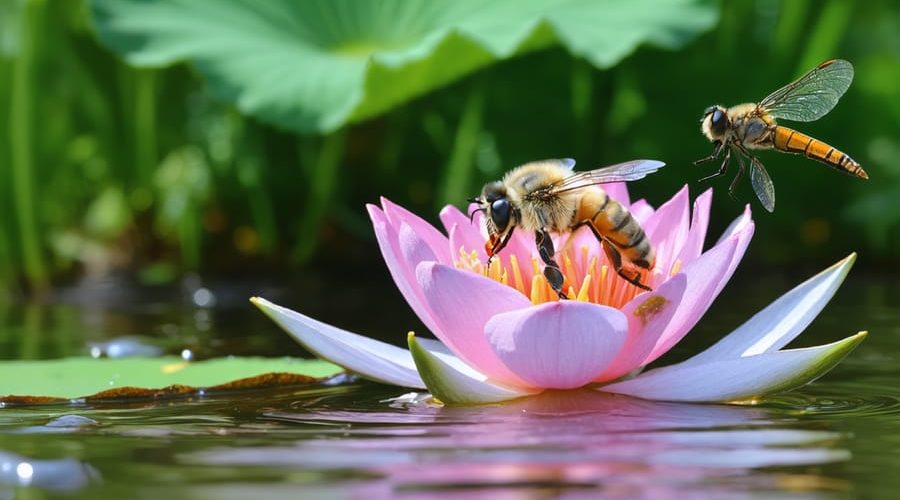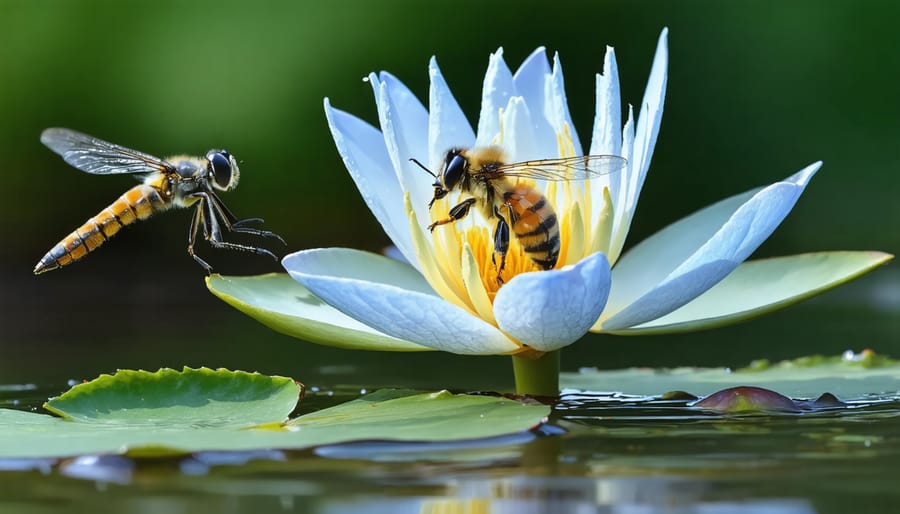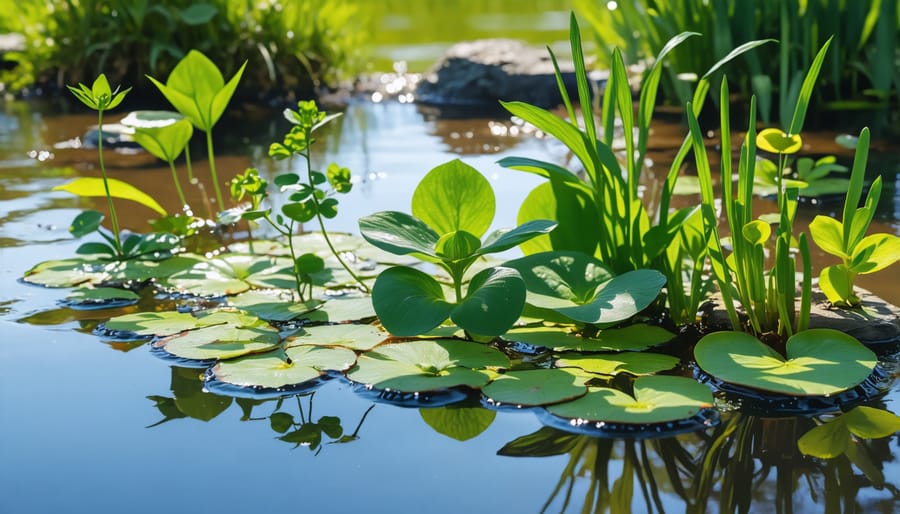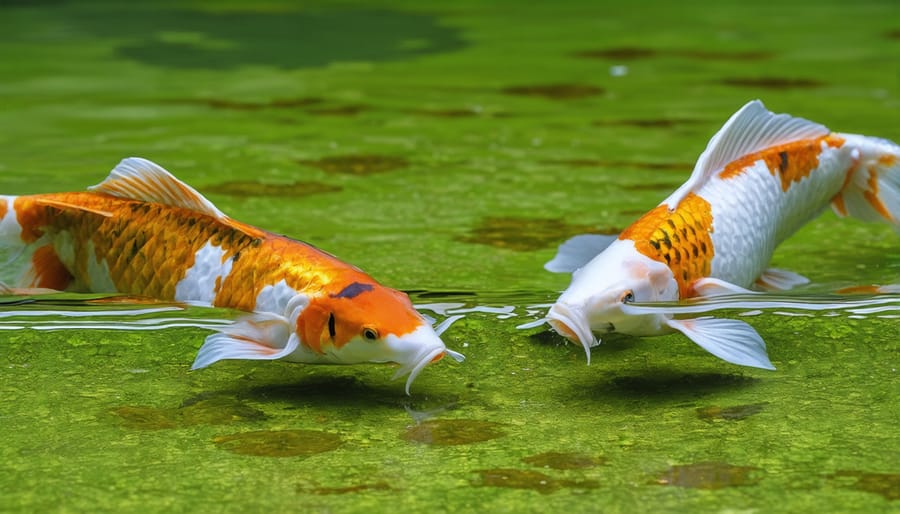
These Hidden Pond-Plant Relationships Shape Your Water Garden’s Success
Nature orchestrates an intricate dance in every pond ecosystem, where three fundamental types of interactions shape the delicate balance of life. From the mutually beneficial partnerships between water lilies and algae-eating fish to the fierce competition for resources among aquatic plants, these relationships create a fascinating web of interdependence. Whether you’re a pond enthusiast or a curious observer, understanding these interactions – symbiosis, competition, and predation – unlocks the secret to maintaining a thriving aquatic environment. These natural dynamics not only determine which species flourish or struggle but also provide valuable insights into how we can better manage our water gardens. By recognizing these patterns, you’ll discover why certain combinations of pond life work harmoniously while others create imbalance, enabling you to make informed decisions about stocking and maintaining your aquatic sanctuary.
Mutually Beneficial Partnerships: Symbiotic Relationships
Pollination Partners
In your pond ecosystem, pollinators play a crucial role in helping marginal plants reproduce and thrive. Insects like bees, butterflies, and even some surprising visitors like hover flies are frequent visitors to pond-side blooms. These helpful creatures transfer pollen between flowers as they move from plant to plant, ensuring successful seed production and maintaining the genetic diversity of your water garden’s flora.
What many pond owners don’t realize is that some amphibians also contribute to pollination, albeit indirectly. As frogs and newts move through marginal plants, pollen often sticks to their moist skin. When they travel to different areas of your pond, they inadvertently help with pollen distribution, especially among low-growing marginal plants.
To encourage these beneficial pollination partnerships, consider planting native flowering species around your pond’s edge. Plants like marsh marigold, purple loosestrife, and yellow flag iris not only provide beautiful blooms but also attract diverse pollinators. Creating shallow areas with stepping stones or partially submerged rocks gives amphibians easy access to different parts of your pond while they assist with pollination.
The relationship between marginal plants and their pollinators is a perfect example of mutually beneficial interaction in your pond ecosystem. The plants provide nectar and pollen as food sources, while the insects and amphibians help ensure the plants’ survival through successful pollination.

Natural Filtration Teams
In a pond ecosystem, one of the most fascinating partnerships exists between aquatic plants and various organisms that work together to maintain crystal-clear water. Think of it as nature’s own filtration system, where each member plays a vital role in keeping the water clean and healthy.
Water plants, such as water lilies and submerged vegetation, act as natural filters by absorbing excess nutrients and providing shelter for beneficial microorganisms. These tiny helpers break down organic waste and convert harmful compounds into nutrients that plants can use. Meanwhile, snails and small crustaceans graze on algae and debris, preventing them from accumulating and clouding the water.
The relationship goes even deeper with filter-feeding fish like koi and goldfish. As they swim and feed, they stir up sediment that would otherwise settle on the bottom. This movement allows beneficial bacteria to process the waste more effectively. Aquatic insects join this cleanup crew by consuming floating organic matter and helping to maintain the delicate balance of the ecosystem.
This natural filtration team demonstrates a perfect example of mutualism, where different species benefit from working together. When all these elements are in harmony, pond owners often find they need less mechanical filtration and fewer chemical treatments to maintain clear, healthy water.
Competition: The Natural Balance
Space and Resource Sharing
In any ecosystem, including your backyard pond, living organisms must share limited resources to survive. This competition plays a crucial role in shaping how different species interact and thrive. Just like in nature, pond plants and wildlife constantly compete for essential resources like sunlight, nutrients, and space.
Take sunlight, for example. Taller plants often shade out shorter ones, leading to a natural competition for light. This is why you might notice some plants growing taller or leaning toward sunnier spots. In your pond, floating plants might block sunlight from reaching submerged varieties, creating a constant battle for light exposure.
Nutrients are another valuable resource that organisms compete for. Plants extend their root systems to access more nutrients, sometimes interfering with neighboring plants. In water gardens, this competition becomes especially noticeable when multiple species vie for dissolved nutrients in the water.
Territory or space is equally important, particularly for wildlife. Fish may compete for preferred hiding spots or breeding areas, while plants spread their leaves to claim more surface area. Some plants even release chemicals to prevent others from growing too close, a fascinating process called allelopathy.
Understanding these competitive relationships helps you create a more balanced ecosystem. By carefully selecting and positioning your plants and managing nutrient levels, you can help ensure all species have access to the resources they need to thrive.

Managing Competitive Balance
Maintaining healthy competition in your pond ecosystem requires a delicate balance, much like conducting an orchestra. The key is to ensure no single species dominates the environment while still allowing natural interactions to occur. Start by carefully selecting plants that won’t outcompete each other for nutrients and sunlight. For instance, pair floating plants like water lilies with submerged plants such as hornwort, ensuring each has enough space to thrive.
Monitor your fish population density regularly. Too many fish competing for limited resources can lead to stress and poor health. A good rule of thumb is one inch of fish per gallon of water. If you notice fish regularly competing for food or becoming aggressive, consider reducing the population or increasing feeding zones.
Plant placement also plays a crucial role. Space out similar species to reduce direct competition for resources. Create different depth zones in your pond to allow various plant species to find their optimal growing conditions without overwhelming each other.
Keep an eye on invasive species, which can quickly throw off the competitive balance. Regular maintenance, including removing excess plant growth and monitoring water quality, helps ensure all species have fair access to resources. Remember, some competition is natural and healthy – your goal is to manage it, not eliminate it entirely.
Predator-Prey Dynamics
Beneficial Predators
While some pond owners might worry about predators, many play a vital role in maintaining a healthy ecosystem. Understanding these beneficial predator-prey relationships can help you create a more balanced water garden.
Dragonfly nymphs and diving beetles are excellent natural controls for mosquito larvae, helping keep these pesky insects in check without the need for chemicals. Frogs and toads not only add charm to your pond but also feed on various insects and slugs that might otherwise damage your aquatic plants.
Fish like koi and goldfish help maintain water quality by consuming excess algae and plant debris. They also feed on insect larvae and small crustaceans, preventing any single species from becoming too numerous. Even predatory insects like water boatmen and backswimmers contribute by consuming dying plant matter and controlling smaller insect populations.
Larger predators, such as herons and kingfishers, might occasionally visit your pond. While they might eat some fish, they also help control populations of smaller prey animals, preventing overcrowding. This natural balance ensures that no single species dominates the ecosystem, leading to better water quality and a more diverse, vibrant pond environment.
Remember, a pond with healthy predator populations often requires less maintenance and intervention from you as the owner.

Plant Protection Strategies
Plants have evolved fascinating defensive mechanisms to protect themselves from herbivores in their ecosystem. Some plants produce thick, waxy coatings on their leaves that make them difficult to chew, while others develop thorns, spines, or prickles that discourage animals from eating them. Water lilies, for example, often have tough leaves that resist damage from aquatic grazers.
Chemical defenses are another clever strategy plants use. Many species produce bitter compounds or toxins that make them unpalatable or even poisonous to potential predators. These natural pesticides can cause stomach upset, bad taste, or other deterrent effects that teach herbivores to avoid them in the future.
Some plants have developed partnerships with protective insects like ants, offering them nectar or shelter in exchange for defending against leaf-eating insects. Others release volatile compounds when damaged, which attract predatory insects that will attack the herbivores eating the plant.
Physical adaptations can include growing closer to the ground to avoid being eaten, developing harder stems, or producing leaves with serrated edges. Many aquatic plants can also regrow quickly from their roots if their above-water parts are damaged, while some species time their growth to avoid periods when herbivores are most active.
Understanding these natural defense mechanisms can help pond owners choose resilient plants and create balanced ecosystems where plants can thrive alongside their natural consumers.
Understanding the three types of interactions in your pond ecosystem – symbiosis, competition, and predation – is crucial for maintaining a healthy and balanced water garden. By recognizing these relationships, you can make informed decisions about which species to introduce and how to support their coexistence.
To maintain a thriving pond ecosystem, consider these practical tips: First, ensure proper plant diversity by including different types of aquatic vegetation that provide food, shelter, and oxygen. Second, maintain appropriate fish populations to prevent overcrowding and excessive competition for resources. Third, introduce beneficial bacteria to support natural decomposition processes.
Regular monitoring is key – observe your pond’s inhabitants and their interactions. Look for signs of stress or imbalance, such as aggressive behavior between fish or declining plant health. Remember that a balanced ecosystem is self-regulating, but may need occasional intervention.
Consider creating designated zones within your pond to support different species’ needs. This might include shallow areas for marginal plants, deeper sections for fish, and quiet corners for smaller organisms. By working with nature’s natural relationships rather than against them, you’ll create a sustainable and beautiful water feature that brings joy for years to come.
